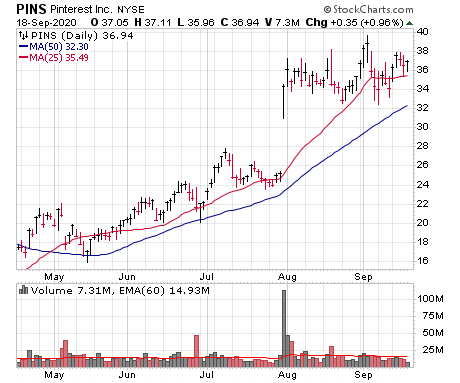This week we are going right back to a stock that we were involved with last month, which has handled the market weakness very well.
Cabot Profit Booster 142
We closed five positions in the Cabot Profit Booster portfolio following September expiration … and I’m happy to say it was another spectacular month!
Here are the big profits, and one tiny loss:
MTH profit of $780 per covered call, or a yield of 8.45%
PINS profit of $315 per covered call, or a yield of 9.89%
APPS profit of $250 per covered call, or a yield of 12.5%
BLDR profit of $200 per covered call, or a yield of 7.14%
JD loss of $70 per covered call, or a loss of 0.93%
JD was our first losing trade in many, many months. I’m sure we will have other trades go bad at some point. That being said, if a loss of 0.93% is our one trade that goes sideways amidst 20 straight wins, this is a scenario I can deal with.
Moving on to this week’s idea, we are going right back to a stock that we were involved with last month, which has handled the market weakness very well. Here is that stock and covered call trade:
The Stock – Pinterest (PINS)
We wrote about Pinterest, the visual social media company, last month, pointing out its incredible growth since its IPO last year as well as its coming out party after Q2 results—it’s looking like the platform will be one of the big winners of the shift to e-commerce in the wake of the virus, and given that it hasn’t been overplayed, there remain many big investors that will be building positions.
The eye opener for the Q2 report was that the company saw a whopping 39% rise in its monthly active users, and at the time of its report, said that July-to-date advertising revenue was up a whopping 50% (though it guided Q3 to a tamer 30% growth rate).
It’s more than just the pandemic that’s helping—in May, Pinterest launched Shopping Spotlights, which allows users to purchase curations by guest editors such as influencers and publishers. And to broaden that category, as well as its content, the company just stole away Aya Kanai, the former editor in chief of Marie Claire.
Since Pinterest’s platform allows users put their interests and hobbies out there for the world to see, it’s a natural progression to offer them items for sale, tailored especially for them, resulting in a way to increase time spent on the site. The potential is enormous, with recent stats from Shopify reporting that 9 of 10 consumers say “Pinterest helps them decide what to buy and 78% say the venue is useful in evaluating items to purchase.” Translation: Pinterest appears set to take its place among the key online/e-commerce destinations, which should keep sales and earnings (Q3 should show a profit) growth humming.
Technical Analysis
PINS quacks like a new leader. After crashing as low as 10 earlier this year, the stock jaggedly advanced into July before exploding higher after Q2 results. While the action has been choppy since then, we think the fact that the stock hasn’t given up any of those gains (even as many growth stocks have been hit) is a plus. Bottom line, it looks like PINS wants to head higher if the market can stabilize. Stop — 31
The Covered Call Trade
Buy Pinterest (PINS) Stock at 38.75, Sell to Open October 39 Strike Calls (exp. 10/16/2020) for $2, or a Net Price of 36.75 or less
Static Return: $200 per covered call (5.44%)
Breakeven: 36.75
Covered Call Return (if assigned): $225 per covered call (6.12%)
Please note, the stock and options prices will be moving throughout the day, so these prices are simply an approximation of prices that you should be able to achieve.
However, the important component of this equation is that the stock price paid, minus the premium received via the call sale, equals the Net Price, of 36.75 or less. (In this case 38.75 minus 2 = 36.75. Or another example is you could pay 38 for the stock and sell the call for 1.25, which also equals 36.75)
For every 100 shares of stock you buy, you can sell 1 call. For every 200 shares of stock you buy, you can sell 2 calls. And so on …
Open Positions


